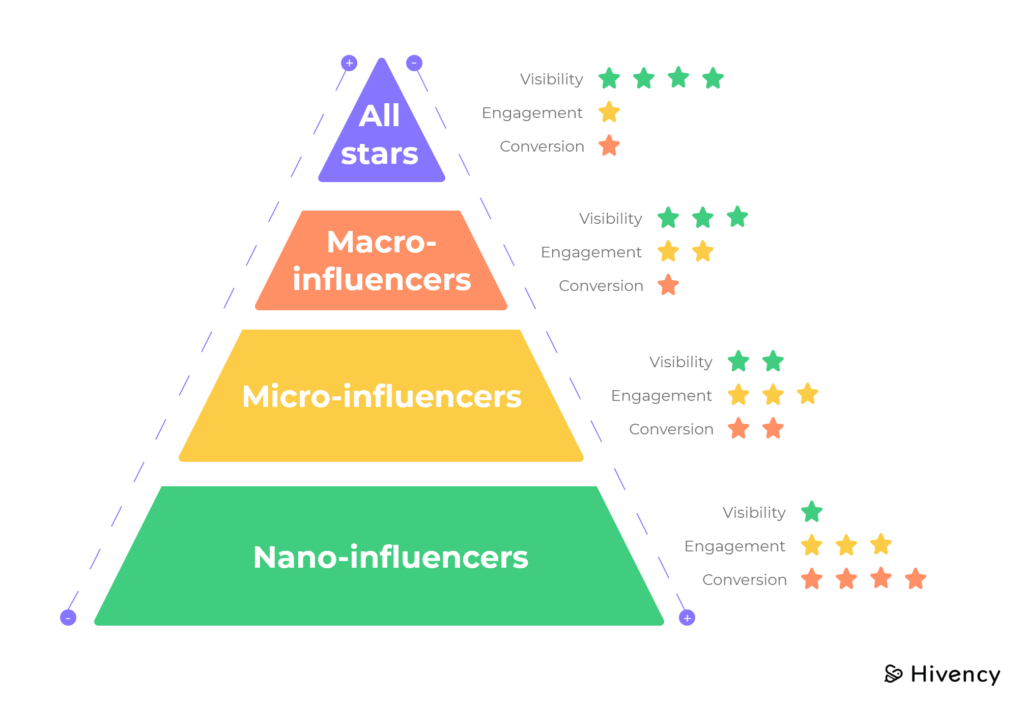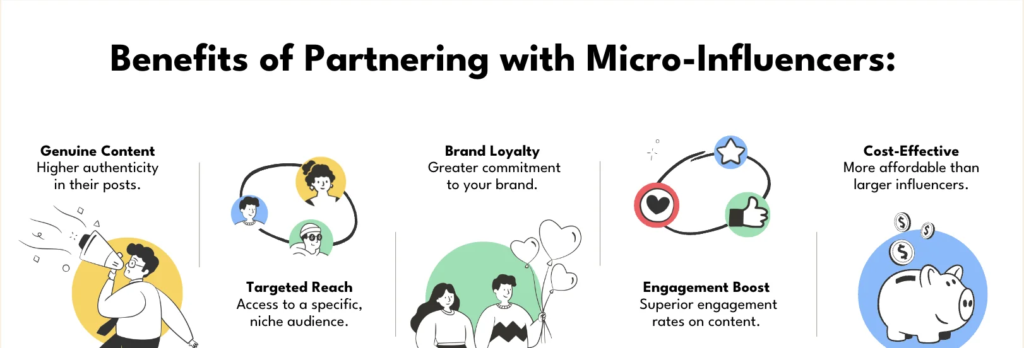UGC Trends in 2025 : Unlock the Future of User-Generated Content.
DiscoverNano, Micro, Macro Influencers: Who to Choose for Your Campaign?
 7
mn
7
mn

Influencers have become the heartbeat of modern marketing campaigns, playing a crucial role in connecting brands with their audiences in authentic and meaningful ways. With the rise of social media, influencers have grown into powerful brand ambassadors, capable of driving awareness, trust, and even sales. But with so many influencers to choose from, how do brands decide which ones to work with? This is where the challenge lies—should you go for nano, micro, or macro influencers?
Each category comes with its own set of advantages and drawbacks, depending on your campaign goals. In this blog, we’ll dive into the key differences between these influencer types, helping you decide which one is the best fit for your brand’s next big campaign.
Understanding Influencer Tiers

When choosing the right influencers for your campaign, it’s essential to understand the differences between nano, micro, and macro influencers. Each tier has its unique advantages depending on your goals, budget, and target audience. Let’s break down the key characteristics of each to help you make an informed decision.
Nano Influencers (1K-10K Followers)
Nano influencers are individuals with small but highly engaged followings—typically between 1,000 and 10,000 followers.
Why Are They Appealing?
Despite their smaller reach, nano influencers often boast a much more personal relationship with their audience. Their followers see them as relatable, trustworthy, and authentic, making them ideal for niche marketing. Nano influencers have the power to create more meaningful connections and generate higher engagement rates compared to larger influencers.
Why They’re Great for Niche Targeting?
If your brand caters to a specific audience, nano influencers can help you reach a dedicated group of potential customers. Their recommendations feel more personal, and their followers are often more likely to trust their opinions, making them an excellent choice for niche campaigns. They are also highly cost-effective, which is perfect for brands with smaller budgets.
Micro Influencers (10K-100K Followers)
Micro influencers typically have followings ranging from 10,000 to 100,000.
Why Do They Balance Reach and Engagement?
Micro influencers offer a sweet spot between reach and engagement. With a moderately larger following, they can reach a broader audience while maintaining high levels of engagement. These influencers tend to be more specialized than macro influencers, yet still have the ability to generate significant exposure.
Why Are They Perfect for Building Brand Loyalty?
Micro influencers are often viewed as more accessible than macro influencers, making their audience more likely to form a deeper connection with your brand. They are highly effective for campaigns focused on building long-term relationships, brand loyalty, and trust. Their genuine content and thoughtful recommendations help foster a sense of community around your brand.
Macro Influencers (100K+ Followers)
Macro influencers have large followings, typically ranging from 100,000 to several million followers.
Why Do They Offer Large-Scale Visibility?
With a massive audience, macro influencers can drive significant brand awareness and reach a vast number of people. Their content is often professionally curated, and they’re well-suited for high-visibility campaigns targeting a broader demographic with a very high budget.
Why Do They Drive Significant Traffic and Brand Awareness?
Macro influencers are tools for brand visibility, especially for high budget campaigns focused on mass-market appeal. They can spread awareness and generate buzz, but may come at a higher cost due to their reach. They are particularly effective if your goal is to capture the attention of a broad, diverse audience.
Pros and Cons of Nano, Micro, and Macro Influencers
Choosing the right influencer for your campaign depends on understanding the pros and cons of nano, micro, and macro influencers. Each comes with its unique set of strengths and weaknesses, so it’s important to weigh them carefully to align with your marketing goals.

In summary, each type of influencer offers distinct advantages and drawbacks. Nano influencers are great for high engagement and authenticity in niche markets, but their reach is limited. Micro influencers provide a balance of affordability and better engagement for more targeted campaigns, while macro influencers excel in mass visibility and brand awareness but come with higher costs and lower engagement rates. Understanding these pros and cons will help you choose the right influencer for your campaign goals.
Which Influencer Tier is Right for Your Campaign?
Choosing the right influencer for your campaign requires aligning your goals, budget, and target audience. By evaluating these factors, you can decide between nano, micro, or macro influencers to get the best results. Let’s break down how to determine which influencer tier is the best fit for your campaign.
Campaign Goals: Awareness (Macro Influencers) vs. Engagement/Trust (Nano/Micro Influencers)

Your campaign goals will largely determine which influencer tier to choose. If your goal is to build broad mass market brand awareness supported by a high budget, then macro influencers are likely the best fit. With their massive followings (often 100K+ followers), they can put your brand in front of a large audience and increase your reach.
However, if your goal is engagement, trust-building or conversion, nano and micro influencers are more effective. These influencers have a more intimate relationship with their followers, leading to higher engagement rates and stronger levels of trust.
Budget Considerations: Balancing Influencer Selection with Campaign Budget
When it comes to your budget, understanding the cost-effectiveness of each influencer tier is crucial. Nano influencers are the most cost-effective, often charging little to nothing or only asking for free products. They have the lowest cost per engagement on social media platforms precisely on Instagram ($0.51) and TikTok ($0.27). This makes them an excellent choice for smaller brands with a limited budget.
Micro influencers are also affordable depending on their reach and the scale of the campaign. They are the perfect middle ground for brands wanting to reach a wider audience while maintaining strong engagement.
Macro influencers are the most expensive due to their large following and brand clout. Their fees can range from $5,000 to $50,000 or more per post, making them ideal for high-budget campaigns aiming for massive exposure.
Target Audience: Choosing the Right Influencer Size for Your Niche or Broad Market
Nano influencers excel in niche markets, where their small but loyal following is more likely to resonate with the brand’s message. They are best suited for highly specific products or services aimed at a focused group. 69% of consumers are more likely to trust products endorsed by influencers with niche, authentic content.
Micro influencers, with a high reach and high engagement, are perfect for brands targeting subgroups within a broad market. They strike a balance by reaching specific yet sizable groups, while still maintaining high engagement.
Macro influencers are ideal for brands targeting a generic, broad audience or seeking mass visibility. Their vast reach allows them to spread brand awareness to a global market, but engagement may be less personalized.
Brand Fit: Assessing Which Influencer Aligns Best with Your Brand Values
Choosing an influencer who aligns with your brand values is essential. A successful collaboration relies on both the influencer’s personal brand and your brand’s ethos matching. Nano and micro influencers tend to work best for brands that value authenticity and trust, as their content feels more personal and genuine.
On the other hand, macro influencers are often better suited for larger brands that are looking for high visibility and want to align with influencers who have a broader, more mainstream appeal.
Conclusion
Choosing the right influencer tier, nano, micro, and macro influencers, is key to the success of your marketing campaign. Each influencer tier offers distinct advantages, so it’s important to align your choice with your campaign goals, budget, and target audience. Whether you’re looking for high engagement with niche communities or broad reach with mass-market appeal, selecting the right influencer type can help you achieve your objectives and deliver the best results.
Interested in finding out more?
Hear What Matters.
Act with Impact.
Book a demo to see how unified reviews and feedback can fuel smarter decisions, stronger connections, and serious growth.

















